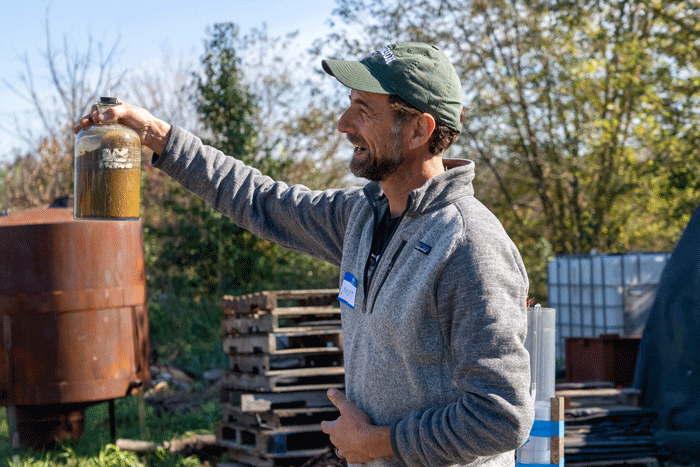'Waste to Energy' Project at Dickinson's College Farm Set to Be National Model

Matt Steiman, the farm’s livestock and energy projects manager, with a sample container of the waste products the farm is transforming into a burnable gas. Photo by Joe O'Neill.
Large grants fund new project that looks to transform the way midsize farms manage waste—and turn it into an energy source
by Tony Moore
If you’re developing a system to turn food and farm waste into biogas and fertilizer via anaerobic digestion, you know you’re doing something right when you’re awarded grants to support the effort.
But how about when those grants come from the USDA Natural Resource Conservation Service, the U.S. Environmental Protection Agency, the Met-Ed Sustainable Energy Fund, Constellation Energy, the Pennsylvania Department of Agriculture and the South Mountain Partnership? And they add up to more than $1 million? Well, it’s clear you’re onto something big.
This is what’s going on at Dickinson’s organic College Farm right now. And those grants will go a long way toward more research, outreach and construction of an automated commercial digester system—one that will become the backbone of a project that will serve as a resource for other midsize farms across the country.
Agricultural showcase
According to Matt Steiman, the farm’s livestock and energy projects manager, the system will process the manure from 150 local dairy cows plus two tons of food waste every day. The food waste will be sourced from places such as Dickinson’s dining services, Project SHARE, the Carlisle Area School District and Molly Pitcher Brewing Company (from which the farm has already processed over 70,000 pounds of spent grain) and will generate about 200,000-300,000 kWh per year of renewable electricity. With that electricity, the farm will power its operations as well as the planned Farm Lab education facility and sell the remainder back to Met-Ed, a Pennsylvania-based power company. And the undertaking is designed to be a roadmap for others to follow.
“Our project will be a showcase for dairy farms in our region,” says Steiman, noting that the new technology he and his team are using could benefit about 5,000 dairy operations in Pennsylvania. “And we’ll serve as a resource for other midsize farms with an interest in commercial biogas digestion systems.”
So, how does it all work?
You might be wondering how this all works, turning food waste and cow manure into electricity. Here’s how Steiman explains the process, in four handy steps:
- When animal and food waste is mixed with water and placed in a warm, airtight tank, the microbes in the waste break it all down into simpler components.
- Since oxygen is not available in the airtight tank, microbes use a different pathway to metabolize those components: fermentation.
- During fermentation, microbes called methanogens convert complex organic molecules into simpler ones while also producing one of two biproducts: methane gas.
- The broken-down organic matter exits the system as the second biproduct: a solid called digestate.
Methane-rich biogas is combustible for heat, cooking or as engine fuel, and digestate can be used as a valuable crop fertilizer. The farm uses the gas they currently produce in the pilot-scale digester for cooking, and when the larger project comes online, they’ll convert that gas to electricity on site in an engine generator.
Sustainability in action
“Anaerobic digestion systems present multiple opportunities for farms to improve their local environment,” says Steiman, noting that the responsible manure management allows farms to reduce nutrient and sediment pollution in waterways and groundwater. “And the renewable electricity generated by a biogas system is carbon neutral and can directly replace fossil fuel energy sources. Our modestly sized project should offset the emission of 150-300 tons of greenhouse gases per year, and expanding this to multiple farms will greatly enhance the positive environmental impact of our effort.”
To extend the benefits of the system, Steiman says he’ll continue to promote the project through networking and online outreach, bringing as many local and national farms as possible into the fold.
“We’re collecting data and will share our production and economic results with farmers and ag and recycling professionals through the web, educational field days and conference presentations,” he says. “Since we landed the $300,000 EPA grant—only one of 12 projects funded nationwide out of over 100 applicants, and the only small college—we’ve gained some notoriety in the anaerobic digestion field.”
TAKE THE NEXT STEPS
Published December 20, 2021